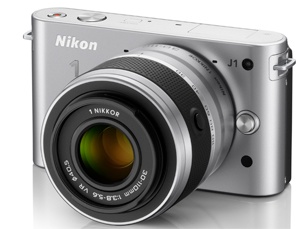By Laura Excell
Nikon (www.nikonusa.com) has entered the mirrorless camera market with a strong start by introducing their new Nikon 1 system (which starts at US$649.95 in pricing), which includes the J1 and V1 cameras.
They did not, however, take the same route as other manufacturers with a 4/3 system but came up with their own sensor size, which they call CX format (slightly smaller than the 4/3 and APS-C format cameras). The CX-format CMOS sensor has a 2.7x magnification/crop factor, providing users with a range of 27-297mm with four lenses to choose from: Their 10mm, 2.8 is an ultra-compact, fast lens; the 10-30mm and 30-110mm provide a full range of focal lengths in just two lenses; and the 10-100mm provides the same range in a single lens (albeit a bit heavy and bulky) with Nikon’s well-respected glass.
The specs of the J1 (which I tested) read very much like many sophisticated DSLR bodies, yet the J1 is very easy to operate and uncluttered. The key settings are available at the push of a button on the exterior of the camera and many more adjustments can be accessed from the menu.
Some key features that set the Nikon 1 system apart from others include Nikon’s new hybrid AF system that combines phase detection/contrast-detect AF with a 73-point focus array, which continually works to keep your subject in sharp focus. Add an auto advance of 5 fps (frames per second) in full-res mode (up to 60 fps in electronic Hi mode) and you won’t miss a single shot.
Want to make a movie? The J1 offers 1080p video-capture, with single-frame capture while filming at the touch of the shutter – without interrupting the video. Don’t want video, but want to capture a mini sequence? The new one-touch Motion Snapshot captures short bursts (approximately 1 second), ensuring you capture that special moment at precisely the right time. Additionally, the J1 is equipped with ultra-slow-motion video for creative special effects that are only available in much higher-end cameras at a much greater cost.
The J1 is geared toward the hobbyist, so I decided to test it without reading the manual, to see just how intuitive it was. I was pleased to find that I could make many adjustments without referring to the instructions. (I later read the instruction book to make sure I was optimizing the camera and getting the most out of the features it offers.)
To keep the camera compact, one sacrifice was made: the lack of a viewfinder. And this proved problematic in bright light when I couldn’t see the rear LCD to compose my shot. At 10 megapixels, however, the J1 doesn’t sacrifice quality for size and I was pleasantly surprised at how low the noise was at higher ISO settings.
And if that’s not enough, Nikon has announced that they’ll offer the FT-1 Mount Adapter to accommodate F-mount single lens reflex (SLR) lenses in the near future. While adding an SLR lens to the camera will totally overpower the body, it does offer the opportunity to increase the magnification range to an extreme at 2.7x the effective focal length of the lens attached.
With all the features and accessories that the Nikon 1 system offers, it fills a niche for photographers, from the snapshot shooter who wants more than a point-and-shoot offers to the serious shooter who’s looking for a compact, full-featured camera with RAW capabilities.
The highlights for my shooting with the J1 include: the broad range of focal lengths offered in a compact camera, the high speed that ensures peak-of-action capture, and the RAW format. Of course, HD video is also a plus. The downside to the J1 is the lack of a viewfinder, making it difficult to see the rear LCD in bright light. But, if that’s a deal breaker, there’s always the V1! (The V1 also includes Nikon’s new multi-accessory port for attaching options such as the new SB-N5 Speedlight.)
Rating: 7 out of 10
(This review is brought to you courtesy of “Layers Magazine”: http://layersmagazine.com/ .)


